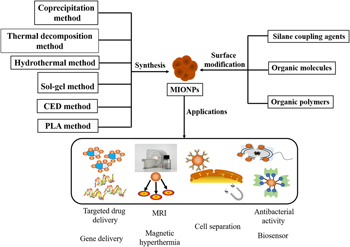Crossref Citations
This article has been cited by the following publications. This list is generated based on data provided by
Crossref.
Bruschi, Marcos Luciano
and
de Toledo, Lucas de Alcântara Sica
2019.
Pharmaceutical Applications of Iron-Oxide Magnetic Nanoparticles.
Magnetochemistry,
Vol. 5,
Issue. 3,
p.
50.
Cetin, Asude
Önal, Ahmet M.
and
Esenturk, Emren Nalbant
2019.
Nanowires assembled from iron manganite nanoparticles: Synthesis, characterization, and investigation of electrocatalytic properties for water oxidation reaction.
Journal of Materials Research,
Vol. 34,
Issue. 18,
p.
3231.
Natarajan, Subramanian
Harini, Kannan
Gajula, Gnana Prakash
Sarmento, Bruno
Neves-Petersen, Maria Teresa
and
Thiagarajan, Viruthachalam
2019.
Multifunctional magnetic iron oxide nanoparticles: diverse synthetic approaches, surface modifications, cytotoxicity towards biomedical and industrial applications.
BMC Materials,
Vol. 1,
Issue. 1,
Katz, Evgeny
2019.
Synthesis, Properties and Applications of Magnetic Nanoparticles and Nanowires—A Brief Introduction.
Magnetochemistry,
Vol. 5,
Issue. 4,
p.
61.
Qurrat-ul-Ain, Qurrat-ul-Ain
Khurshid, Sumaira
Gul, Zarnab
Khatoon, Jaweria
Shah, Muhammad Raza
Hamid, Irum
Khan, Iffat Abdul Tawab
and
Aslam, Fariha
2020.
Anionic azo dyes removal from water using amine-functionalized cobalt–iron oxide nanoparticles: a comparative time-dependent study and structural optimization towards the removal mechanism.
RSC Advances,
Vol. 10,
Issue. 2,
p.
1021.
Khizar, Sumera
Ahmad, Nasir M.
Ahmed, Naveed
Manzoor, Sadia
and
Elaissari, Abdelhamid
2020.
Encapsulation of doxorubicin in magnetic‐polymer hybrid colloidal particles of Eudragit E100 and their hyperthermia and drug release studies.
Polymers for Advanced Technologies,
Vol. 31,
Issue. 8,
p.
1732.
Hossain, Sadia
Rahman, Mahbubor
Nahar, Yeasmin
Rahman, Abdur
Sharafat, Mostafa Kaiyum
Hossain, Motahar
Ochiai, Bungo
Elaissari, Abdelhamid
and
Ahmad, Hasan
2020.
A simple in situ synthesis of iron oxide magnetic nanoparticles embedded in thermosensitive polymer for DNA capture.
Journal of Materials Research,
Vol. 35,
Issue. 18,
p.
2441.
Putz, Ana-Maria
Ianăși, Cătălin
Dudás, Zoltán
Coricovac, Dorina
Watz, Claudia (Farcas)
Len, Adél
Almásy, László
Sacarescu, Liviu
and
Dehelean, Cristina
2020.
SiO2-PVA-Fe(acac)3 Hybrid Based Superparamagnetic Nanocomposites for Nanomedicine: Morpho-textural Evaluation and In Vitro Cytotoxicity Assay.
Molecules,
Vol. 25,
Issue. 3,
p.
653.
Toledo-Jaldin, Helen Paola
Sánchez-Mendieta, Víctor
Blanco-Flores, Alien
López-Téllez, Gustavo
Vilchis-Nestor, Alfredo Rafael
and
Martín-Hernández, Osnieski
2020.
Low-cost sugarcane bagasse and peanut shell magnetic-composites applied in the removal of carbofuran and iprodione pesticides.
Environmental Science and Pollution Research,
Vol. 27,
Issue. 8,
p.
7872.
Gutiérrez-Serpa, Adrián
Napolitano-Tabares, Patricia I.
Šulc, Jakub
Pacheco-Fernández, Idaira
and
Pino, Verónica
2020.
Role of Ionic Liquids in Composites in Analytical Sample Preparation.
Separations,
Vol. 7,
Issue. 3,
p.
37.
Nor, Noorhashimah Mohamad
Razak, Khairunisak Abdul
and
Lockman, Zainovia
2020.
Glucose-sensing properties of citrate-functionalized maghemite nanoparticle–modified indium tin oxide electrodes.
Journal of Materials Research,
Vol. 35,
Issue. 10,
p.
1279.
Wang, Yazhen
Shi, Zhen
Sun, Yu
Wu, Xueying
Li, Shuang
Dong, Shaobo
and
Lan, Tianyu
2020.
Preparation of amphiphilic magnetic polyvinyl alcohol targeted drug carrier and drug delivery research.
Designed Monomers and Polymers,
Vol. 23,
Issue. 1,
p.
197.
Rivera, Luis M. R.
Machado, Julhyana G.
Chandra Mathpal, Mohan
Chaves, Natalia L.
Gregurec, Danijela
Báo, Sônia N.
Paterno, Leonardo G.
Moya, Sergio E.
Azevedo, Ricardo B.
and
Soler, Maria A. G.
2020.
Functional glucosamine-iron oxide nanocarriers.
Journal of Materials Research,
Vol. 35,
Issue. 13,
p.
1726.
Ida, Yumi
Okazawa, Atsushi
Sonobe, Kazutaka
Muramatsu, Hisanori
Kambe, Tetsuya
Imaoka, Takane
Chun, Wang-Jae
Tanabe, Makoto
and
Yamamoto, Kimihisa
2020.
A useful preparation of ultrasmall iron oxide particles by using arc plasma deposition.
RSC Advances,
Vol. 10,
Issue. 68,
p.
41523.
Benavente, Rocio
Lopez-Tejedor, David
del Puerto Morales, Maria
Perez-Rizquez, Carlos
and
Palomo, Jose M.
2020.
The enzyme-induced formation of iron hybrid nanostructures with different morphologies.
Nanoscale,
Vol. 12,
Issue. 24,
p.
12917.
Swain, Sangita K.
Sahoo, Anupam
Swain, Sukanta K.
Tripathy, S. K.
and
Phaomei, G.
2020.
Synthesis of a novel β-cyclodextrin-functionalized Fe3O4/BaMoO4:Dy3+ magnetic luminescent hybrid nanomaterial and its application as a drug carrier.
Dalton Transactions,
Vol. 49,
Issue. 41,
p.
14605.
Mylkie, Kinga
Nowak, Pawel
Rybczynski, Patryk
and
Ziegler-Borowska, Marta
2021.
Polymer-Coated Magnetite Nanoparticles for Protein Immobilization.
Materials,
Vol. 14,
Issue. 2,
p.
248.
Mona, Lijo P.
Songca, Sandile P.
and
Ajibade, Peter A.
2021.
Synthesis and encapsulation of iron oxide nanorods for application in magnetic hyperthermia and photothermal therapy.
Nanotechnology Reviews,
Vol. 11,
Issue. 1,
p.
176.
Song, Shuhui
Li, Xinyi
Ji, Yongsheng
Lv, Ruihong
Wu, Le
Wang, Haohao
Cao, Mingzhuo
and
Xu, Zhigang
2021.
GSH/pH dual-responsive and HA-targeting nano-carriers for effective drug delivery and controlled release.
Journal of Drug Delivery Science and Technology,
Vol. 62,
Issue. ,
p.
102327.
Hallan, Supandeep Singh
Sguizzato, Maddalena
Esposito, Elisabetta
and
Cortesi, Rita
2021.
Challenges in the Physical Characterization of Lipid Nanoparticles.
Pharmaceutics,
Vol. 13,
Issue. 4,
p.
549.
